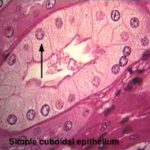- Figure 1
- Figure 2
- Figure 3
- Figure 4
- Figure 5
- Simple epithelium
It consists of single layer of epithelial cells resting on basement membrane.
- Simple squamous epithelium
It consists of a single layer of thin flat, scale-like cells. On surface view ![]() , the cells have an irregular shape with a slightly serrated border. Each cell has a centrally located spherical or oval nucleus.
, the cells have an irregular shape with a slightly serrated border. Each cell has a centrally located spherical or oval nucleus.
![]() In a side view, the cells are so flat that they can only recognize by their elongated nuclei that bulge into the lumen. The cytoplasm is scanty and has sparse organelles .
In a side view, the cells are so flat that they can only recognize by their elongated nuclei that bulge into the lumen. The cytoplasm is scanty and has sparse organelles .
Location: lung alveoli, glomerular capsule of the kidneys, lines the blood and lymph vessels (endothelium), lines the serous membranes (peritoneum, pleura and pericardium) and is called mesothelium, lines the subarachnoid and subdural spaces (mesenchymal epithelium), the anterior chamber of the eye and perilymphatic spaces of the ear.
- Simple cuboidal epithelium
It consists of a single layer of cube-like cells whose width and heights are nearly equal. In sections, the cells are square with spherical centrally located nuclei. It is usually located in organs that have secretory or absorptive functions.
Locations: thyroid follicles, glandular ducts and kidney tubules.
- Simple columnar epithelium
![]() It consists of a single layer of tall, narrow cells having greater height than width. The nuclei are oval and are located near the base of the cells.
It consists of a single layer of tall, narrow cells having greater height than width. The nuclei are oval and are located near the base of the cells.
Locations: simple columnar absorptive with microvili (small intestine, gall bladder), simple columnar secretory (stomach) or simple columnar ciliated (oviducts and bronchioles).
- Pseudostratified columnar epithelium
![]() It is composed of single layer of irregular cells. All the cells rest on the basement membrane but not all the cells reach to the luminal surface. The nuclei are located at different levels, thus creating the illusion of cellular stratification. The cells reaching the surface are either ciliated or goblet cells.
It is composed of single layer of irregular cells. All the cells rest on the basement membrane but not all the cells reach to the luminal surface. The nuclei are located at different levels, thus creating the illusion of cellular stratification. The cells reaching the surface are either ciliated or goblet cells.
The short cell acts as progenitors for the tall cells. The pseudostratified columnar ciliated epithelium may be differentiated from the stratified epithelium by: 1) cilia are never exists on stratified epithelium. 2) the apical cytoplasm of the cell forming the pseudostratified epithelium does not contain nuclei.





